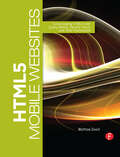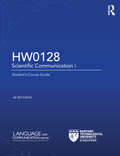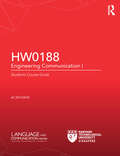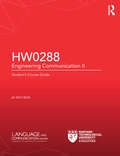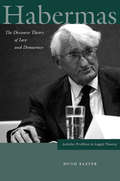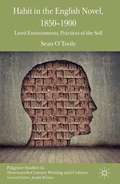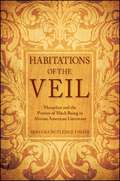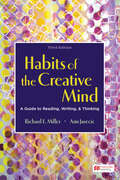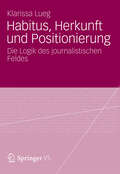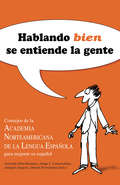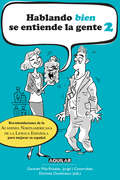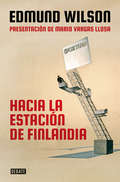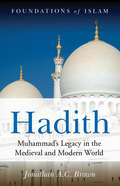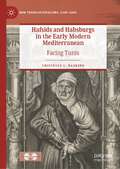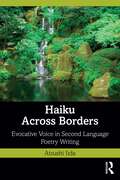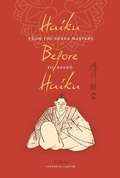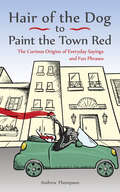- Table View
- List View
HTML5 Mobile Websites: Turbocharging HTML5 with jQuery, Sencha Touch, and Other Frameworks
by Matthew DavidBuild HTML5-powered mobile web experiences with the aid of development frameworks that speed the development of Native App-like experiences. Build on your foundation of HTML and JavaScript with a complete understanding of the different mobile Web browser technologies. You get carefully detailed techniques that are illustrated in full color so you can leverage the Web technologies unique to each mobile browser, apply frameworks such as Sencha Touch to rapidly build out your designs, and design techniques expressly suited for tablet devices. Projects provide hands-on practice and code is provided on the companion website, www.visualizetheweb.com.
HW0128 Scientific Communication I: Student's Course Guide
by Kingsley BoltonThis is the coursebook for Scientific Communication I, a one-semester, 2-credit course for students in the School of Biological Sciences and School of Physical and Mathematical Sciences. The broad aim of this course is to increase students’ abilities in academic communication related to their studies in science as well as in professional communication. Professional scientists not only need expert knowledge relating to science, but they also need to be able to communicate that knowledge, both to their scientific colleagues and also to the wider community. This coursebook is designed to help improve students’ skills in both areas of communication. Accessibly written and rigorously researched it provides up-to-date science-specific vocabulary and exercises to assist students to master Scientific Communication I. Please note: As HW0001 English Proficiency is a co-requisite/pre-requisite for this course, please ensure that you have completed the course, signed up for it this semester or obtained exemption from this requirement.
HW0188 Engineering Communication I: Student's Course Guide
by Kingsley BoltonThis is the coursebook for Engineering Communication I, a one-semester, 2-credit course that aims to enhance students’ abilities in academic communication related to their studies in engineering as well as in professional communication. Professional engineers not only need expert knowledge relating to engineering, but they also need to be able to communicate that knowledge, both to their professional colleagues and also to the wider community. This coursebook is designed specifically for the Engineering Communication I course which aims to help improve students’ skills in both areas of communication. Accessibly written and rigorously researched, it provides up-to-date, engineering-specific vocabulary and exercises to assist students in mastering Engineering Communication I. Please note: As HW0001 English Proficiency is a co-requisite for this course, please ensure that you have completed the course, signed up for it this semester or obtained exemption from this requirement.
HW0288 Engineering Communication II: Student's Course Guide
by Kingsley BoltonThis is the coursebook for Engineering Communication II, a one-semester, 2-credit course that builds upon the foundation course, Engineering Communication I. The broad aim of this course is to further enhance students’ abilities in academic communication related to their studies in engineering as well as in professional communication. Professional engineers not only need expert knowledge relating to engineering, but they also need to be able to communicate that knowledge, both to their professional colleagues and also to the wider community. This coursebook is designed to help improve students’ skills in both areas of communication. Shaped around the Final Year Project and workplace communication, this tried and tested coursebook will aid students in successfully completing Engineering Communication II. Please note: As HW0188 Engineering Communication I is a pre-requisite for this course, please ensure that you have completed the course, signed up for it this semester or obtained exemption from this requirement.
Habermas: The Discourse Theory of Law and Democracy
by Hugh BaxterThough many legal theorists are familiar with Jürgen Habermas's work addressing core legal concerns, they are not necessarily familiar with his earlier writings in philosophy and social theory. Because Habermas's later work on law invokes, without significant explanation, the whole battery of concepts developed in earlier phases of his career, even otherwise sympathetically inclined legal theorists face significant obstacles in evaluating his insights. A similar difficulty faces those outside the legal academy who are familiar with Habermas's earlier work. While they readily comprehend Habermas's basic social-theoretical concepts, without special legal training they have difficulty reliably assessing his recent engagement with contemporary legal thought. This new work bridges the gap between legal experts and those without special legal training, critically assessing the attempt of an unquestionably preeminent philosopher and social theorist to engage the world of law.
Habit in the English Novel, 1850–1900: Lived Environments, Practices of the Self (Palgrave Studies in Nineteenth-Century Writing and Culture)
by Sean O’TooleThe ancient philosophical concept of habit fixated and unsettled the Victorians in profoundly new ways, as advances in physiology and evolutionary theory sparked far-reaching debates about the threat of automatism and the proper mental training of the will. This book suggests that nineteenth-century novelists not only echoed these debates but intervened in them in unique, transformative, and strikingly modern ways. In attending closely to the enabling, generative potential of habit and its role in the creation of new perceptions and social identities, novelists from Dickens to James bequeathed a far more complex conception of the category than has yet been acknowledged, allowing for a rich phenomenology of the unpredictable, changeable modes of modern existence. Habit in the English Novel, 1850-1900 reconsiders what we have come to assume about the Victorian novel, including our own critical habits, in the wake of Freud and cultural modernism.
Habitations of the Veil: Metaphor and the Poetics of Black Being in African American Literature (SUNY series, Philosophy and Race)
by Rebecka Rutledge FisherIn Habitations of the Veil, Rebecka Rutledge Fisher uses theory implicit in W. E. B. Du Bois's use of metaphor to draw out and analyze what she sees as a long tradition of philosophical metaphor in African American literature. She demonstrates how Olaudah Equiano, Frances Ellen Watkins Harper, Zora Neale Hurston, Richard Wright, and Ralph Ellison each use metaphors to develop a critical discourse capable of overcoming the limits of narrative language to convey their lived experiences. Fisher's philosophical investigations open these texts to consideration on ontological and epistemological levels, in addition to those concerned with literary craft and the politics of black identity.
Habits of the Creative Mind: A Guide To Reading, Writing, And Thinking
by Richard E. Miller Ann JurecicHabits of the Creative Mind is a portable and affordable text that centers on ten habits that encourage curious, thoughtful and reflective writing.
Habitus, Herkunft und Positionierung
by Klarissa LuegKlarissa Lueg geht der Frage nach dem Zusammenhang zwischen sozialer Herkunft und der Hierarchie im journalistischen Feld nach. Dabei wird grundsätzlich die Herkunft von ChefredakteurInnen und JournalistenschülerInnen und die Bedeutung dieser sozialen Herkunft für Berufszugang und Positionierungsstrategien erläutert. Es wird deutlich, dass nicht nur die Karrierewege der untersuchten Gruppen selbst ein herkunftsspezifisches Muster aufweisen, sondern dass auch die Verteilung und Zuweisung von Macht im journalistischen Feld eng mit der Herkunft ihrer TrägerInnen verbunden ist.
Hablando bien se entiende la gente
by Asociación Norteamericana de la Lengua Española Gerardo Piña300 cápsulas aclarando el uso correcto del idioma español. Incluye los errores más comunes que cometen los hispanohablantes en EEUU. Con un tono simpático y acompañado de ilustraciones, la Academia Norteamericana de la Lengua Española (ANLE) nos ofrece un manual para que el español sobreviva sin que el spanglish deteriore en EEUU. La ANLE nos da alternativa de uso de esos anglicismos.
Hablando bien se entiende la gente 2
by Academia Norteamericana de la Lengua EspañolaRecomendaciones de la Academia Norteamericana de la Lengua Española para mejorar su español En el anuncio de una sastrería se leía: "Se alteran pantalones". ¿Cómo? ¿Pantalones enojados? Sin duda el anuncio quería decir que se arreglaban pantalones. Aunque el adjetivo alterado significa también cambio "Lo encontré muy alterado; seguramente le habrían dado una mala noticia", en este caso de la sastrería el término más preciso es arreglar. Cuando vives en los Estados Unidos, hablar español correctamente se vuelve una "Misión casi imposible". Cada día usamos más traducciones erróneas para comunicarnos; como es el caso, por ejemplo, del uso de "carpeta", del inglés carpet, para referirnos a la alfombra, o "parquear", del inglés parking, cuando lo que realmente queremos decir es estacionar. En Hablando bien se entiende la gente 2, la Academia Norteamericana de la Lengua Española reanuda la divertida aventura que inició en el 2009. En esta continuación del exitoso Hablando bien se entiende la gente, encontrarás los términos correctos para cientos de palabras así como las respuestas a algunas de las preguntas que nos hacemos más frecuentemente sobre el uso del idioma. Por ejemplo, "¿Se los dije? o ¿se lo dije?". Mmm... muy buena pregunta...
Hacia la estación Finlandia
by Edmund WilsonUN CLÁSICO IMPRESCINDIBLE PARA ENTENDER EL MUNDO EN EL QUE VIVIMOS, CON PRÓLOGO DE MARIO VARGAS LLOSA. «En una era de amnesia histórica, este libro nos recuerda que la historia está viva y abierta y llena de posibilidades y emociones.»The New York Times Book Review En este relato repleto de romance, idealismo, intriga y conspiración, historia intelectual a gran escala, Edmund Wilson rastrea las ideas revolucionarias que dieron forma al mundo moderno desde la Revolución francesa hasta la llegada de Lenin en 1917 a la estación de Finlandia en San Petersburgo. Es una crónica viva y de gran envergadura a la que subyace una idea singular y capaz de cambiar la historia: que es posible construir una sociedad basada en la justicia, la igualdad y la libertad. Anarquistas, socialistas, nihilistas y utópicos cobran vida en estas páginas, y sus ideas permanecen tan provocadoras y relevantes hoy como lo fueron en su tiempo. «Se trata de un libro absolutamente actual, que se puede leer y releer como las grandes novelas, y que, con los años transcurridos desde su publicación, ha ganado encanto y vigor, igual que las obras maestras literarias. […] Se lee como una ficción por la destreza y la imaginación con que está escrito, y la originalidad y la fuerza compulsiva de los caracteres que figuran en él —Renan, Taine, Babeuf, Saint-Simon, Fourier, Owen, Marx y Engels, Bakunin, Lassalle, Lenin y Trotski— que, gracias al poder de síntesis y la prosa de Wilson, se graban en la memoria del lector como los personajes de Los miserables, Los hermanos Karamazov o Guerra y paz. Se trata de una obra maestra que, por razones políticas, fue marginada, pese al altísimo valor que tiene desde el punto de vista literario.» Del prólogo de Mario Vargas Llosa La crítica ha dicho:«En una era de amnesia histórica, Hacia la estación de Finlandia nos recuerda que la historia está viva y abierta y llena de posibilidades y emociones.»Marshall Berman, The New York Times Book Review «Muy de vez en cuando descubres un libro de no ficción cuya trama es más atractiva y más rica en su comprensión de la naturaleza humana que mil novelas juntas. Este es uno de esos libros.»Aravind Adiga, NPR «Uno de los grandes monumentos radicales de nuestro tiempo. [...] Una maravilla de minuciosa erudición, sutil estructuración, elocuencia y fuerza narrativa.»The Observer
Hadith
by Jonathan A. C. BrownContrary to popular opinion, the bulk of Islamic law does not come from the Qur'an but rather from hadith, first-hand reports of the prophet Muhammad's words and deeds, passed from generation to generation. However, with varying accounts often only committed to paper a century after the death of Muhammad, Islamic scholars, past and present, have been faced with complex questions of historical authenticity. Informative and accessible, this wide-ranging introduction provides a detailed exploration of the collection and criticism of hadith and examines the controversy surrounding its role in modern Islam. Complete with a glossary, extensive bibliography, and helpful diagrams, Hadith: An Introduction is perfectly suited to students, scholars, and the general reader interested in this critical element of Islam.
Hafsids and Habsburgs in the Early Modern Mediterranean: Facing Tunis (New Transculturalisms, 1400–1800)
by Cristelle L. BaskinsThis book explores an anonymous sixteenth-century portrait of Muley al-Hassan, the Hafsid king of Tunis (ca. 1528–1550), that bears witness to relations between North Africa, the Habsburgs, and the Ottomans. While Muley al-Hassan appears frequently in the vast literature on Charles V Habsburg, he is overshadowed by the emperor. Here he emerges as a protagonist, a figure whose shifting reputation can be traced well into the seventeenth century. Images of the King of Tunis circulated in broadsheets, ephemeral images made for triumphal entries, manuscripts, tapestry designs, engravings, and books. The ceaseless production of Tunisian imagery allowed Europeans to face their North African counterparts through scenes of battle but also through imaginary encounters and festive cross-dressing. This book shows how portraits of Hafsid rulers challenge assumptions about the absolute divide between Christian and Muslim, sovereign and subject, the familiar and the foreign, and they put a face on the entangled histories of the early modern Mediterranean.
Haiku Across Borders: Evocative Voice in Second Language Poetry Writing
by Atsushi IidaDrawing on a total of 8,308 haiku poems written by 834 English as a foreign language (EFL) university students in Japan, this book explores the value, possibility, and potential of teaching and researching English-language haiku in second and foreign language (SFL) contexts. The book showcases how haiku is used and taught in the SFL classroom and discusses how the task of reading and writing English-language haiku promotes SFL learning. More specifically, it addresses these questions: What are the textual features of English-language haiku produced by EFL students? How do EFL students read and interpret English-language haiku? What knowledge and skills do EFL students gain through the task of reading and writing English-language haiku? What are the perceptions and attitudes of EFL students in relation to the task of reading and writing haiku in the English classroom? How can English-language haiku be used as a research methodology? With empirical evidence from both quantitative and qualitative data, this book moves the field forward by addressing the methodological and pedagogical issues in relation to the use of poetry writing in SFL teaching and learning. The uniqueness of this book lies in its applicability and practicality both in methodological and pedagogical approaches to haiku writing that students, researchers, and teachers in applied linguistics can replicate in diverse teaching contexts.
Haiku Before Haiku: From the Renga Masters to Basho
by Steven D. CarterWhile the rise of the charmingly simple, brilliantly evocative haiku is often associated with the seventeenth-century Japanese poet Matsuo Basho, the form had already flourished for more than four hundred years before Basho even began to write. These early poems, known as hokku, are identical to haiku in syllable count and structure but function differently as a genre. Whereas each haiku is its own constellation of image and meaning, a hokku opens a series of linked, collaborative stanzas in a sequence called renga. Under the mastery of Basho, hokku first gained its modern independence. His talents contributed to the evolution of the style into the haiku beloved by so many poets around the world-Richard Wright, Jack Kerouac, and Billy Collins being notable devotees. Haiku Before Haiku presents 320 hokku composed between the thirteenth and early eighteenth centuries, from the poems of the courtier Nijo Yoshimoto to those of the genre's first "professional" master, Sogi, and his disciples. It features 20 masterpieces by Basho himself. Steven D. Carter introduces the history of haiku and its aesthetics, classifying these poems according to style and context. His rich commentary and notes on composition and setting illuminate each work, and he provides brief biographies of the poets, the original Japanese text in romanized form, and earlier, classical poems to which some of the hokku allude.
Haiku Before Haiku: From the Renga Masters to Basho (Translations from the Asian Classics)
by Steven D. CarterWhile the rise of the charmingly simple, brilliantly evocative haiku is often associated with the seventeenth-century Japanese poet Matsuo Basho, the form had already flourished for more than four hundred years before Basho even began to write. These early poems, known as hokku, are identical to haiku in syllable count and structure but function differently as a genre. Whereas each haiku is its own constellation of image and meaning, a hokku opens a series of linked, collaborative stanzas in a sequence called renga.Under the mastery of Basho, hokku first gained its modern independence. His talents contributed to the evolution of the style into the haiku beloved by so many poets around the world-Richard Wright, Jack Kerouac, and Billy Collins being notable devotees. Haiku Before Haiku presents 320 hokku composed between the thirteenth and early eighteenth centuries, from the poems of the courtier Nijo Yoshimoto to those of the genre's first "professional" master, Sogi, and his disciples. It features 20 masterpieces by Basho himself. Steven D. Carter introduces the history of haiku and its aesthetics, classifying these poems according to style and context. His rich commentary and notes on composition and setting illuminate each work, and he provides brief biographies of the poets, the original Japanese text in romanized form, and earlier, classical poems to which some of the hokku allude.
Hair of the Dog to Paint the Town Red: The Curious Origins of Everyday Sayings and Fun Phrases
by Andrew Thompson400 intriguing, entertaining, and often hilarious etymological journiesEnglish is filled with curious, intriguing and bizarre phrases. This book reveals the surprising, captivating and even hilarious origins behind 400 of them, including:• Read between the Lines• Cat Got Your Tongue?• Put a Sock in It• Close, but No Cigar• Bring Home the Bacon• Caught Red-Handed• Under the Weather• Raining Cats and DogsPerfect for trivia and language lovers alike, this entertaining collection is the ultimate guide to understanding these baffling mini mysteries of the English language.

